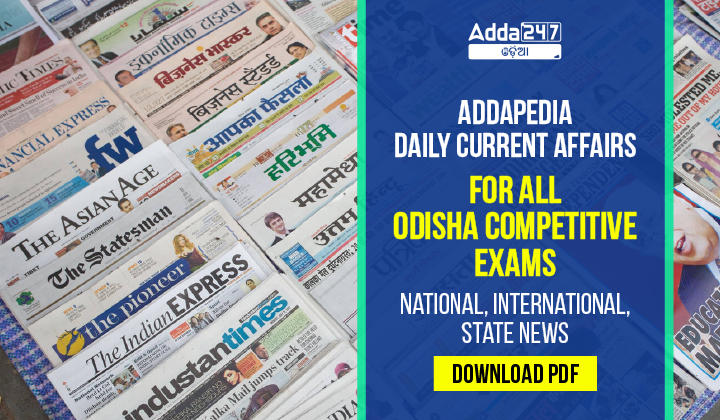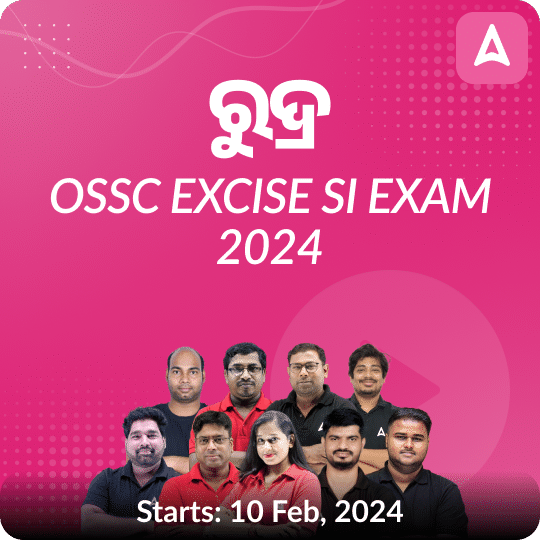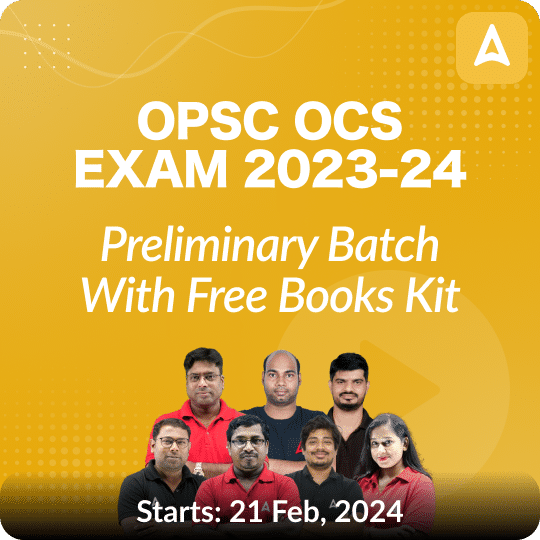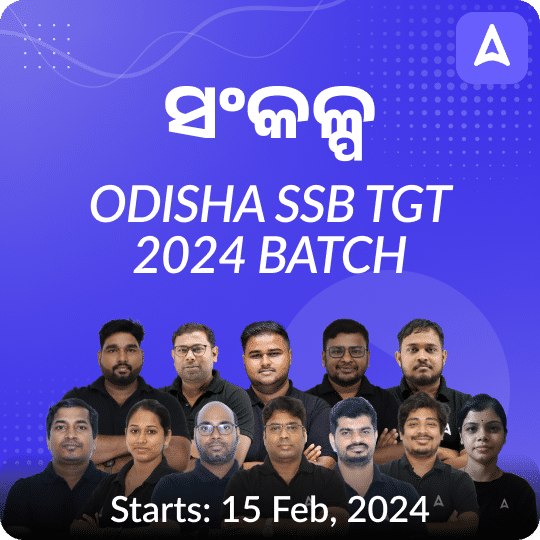As you are aware, in all competitive exams, the “Daily Current Affairs Section” holds significant importance in determining the cutoff scores. Therefore, if you excel in this section, you will have a better chance of achieving higher marks in these exams and securing a spot on the merit list.
Addapedia Odisha – Daily Current Affairs -05 March 2024
| National and International News |
| Women, Business and Law Index |
Context:
India has improved its ranking to 113 out of 190 countries in the World Bank’s Women, Business and Law index.
Key points:
- The index, which measures the enabling environment for women’s economic opportunity in 190 economies, assesses how laws and regulations impact women’s economic rights on a scale of 0 to 100, where 100 signifies equal legal rights for men and women.
- The report evaluates eight key areas: Mobility, workplace, pay, marriage, parenthood, entrepreneurship, assets, and pension.
- This is the 10th edition of the report.
- Globally, no country achieved a perfect score, indicating a lack of equal rights for women worldwide.
- Indian women enjoy 60% of the legal rights given to men, which is lower than the global average of 64.2%.
|
| Prototype Fast Breeder Reactor – Kalpakkam |
Context:
Prime Minister Narendra Modi visited the Kalpakkam nuclear power plant and observed the commencement of “core loading” at India’s first indigenous Fast Breeder Reactor (500 MWe).
Key points:
- In 2003, the government approved the creation of Bhartiya Nabhikiya Vidyut Nigam Ltd. (BHAVINI) to operate India’s most advanced nuclear reactor, the Prototype Fast Breeder Reactor (PFBR).
- The PFBR, fully designed and constructed indigenously by BHAVINI with contributions from 200 Indian industries, is a significant achievement.
- Once commissioned, India will be the second country, after Russia, to have a commercial operating Fast Breeder Reactor.
- The PFBR is an advanced third-generation reactor with inherent passive safety features, ensuring high levels of safety.
PFBR:
- The PFBR, which breeds more material for nuclear fission than it consumes, is a key project of India’s nuclear power programme.
- Initially, the reactor will use uranium-plutonium mixed oxide (MOX) fuel.
- The uranium-238 ‘blanket’ surrounding the fuel core will undergo nuclear transmutation to produce more fuel, earning the name ‘Breeder’.
- The use of Thorium-232 as a blanket is also envisaged.
- Through transmutation, Thorium will create fissile Uranium-233 for use as fuel in the third stage.
- FBR is a stepping stone for the third stage, leading to the full utilization of India’s abundant thorium reserves.
- After core loading, the reactor will approach criticality, generating power subsequently. PFBRs are cooled by liquid sodium, with 1,750 tonnes of liquid sodium to be loaded into the reactor.
- India chose the closed fuel cycle option for this reactor, where spent fuel is reprocessed and converted into indigenously-developed unique plutonium-rich mixed carbide fuel.
|
| Yars Missile |
Context:
- Russia recently conducted a fire test of its nuclear ballistic Yars missile.
Key points:
- The RS-24 Yars is an intercontinental ballistic missile (ICBM) in Russia’s Strategic Missile Forces arsenal.
- It has an operational range of up to 12,000 kilometers, making it one of the longest-range missiles globally.
- The RS-24 Yars features a Multiple Independently targetable Reentry Vehicle (MIRV) system.
- This allows it to carry multiple nuclear warheads, enhancing its strategic deterrence capability.
- The RS-24 Yars replaces the older Topol and Topol-M missile systems.
- It exists in both mobile and silo-based forms to increase flexibility and reliability.
ICBM:
- An intercontinental ballistic missile is a ballistic missile with a range greater than 5,500 kilometres, primarily designed for nuclear weapons delivery.
- Maximum range varies from 7,000 to 16,000 kilometers, according to the Federation of American Scientists.
- Compared to other types of ballistic missiles, ICBMs are significantly faster and have a greater range.
- Agni-V, an Indian ICBM, has a range of over 5,000 kilometers.
|
| Narasapur crochet lace |
Context:
- The Narasapur crochet lace craft, famous in the Godavari region of Andhra Pradesh, has received the Geographical Indications (GI) tag from DPIIT.
- The GI tag aims to revive the craft and boost its demand, especially against competition from machine-made lace products from China.
Key points:
- Originated in 1844 when Macrae and his wife from Scotland taught the lace-making technique to local women at Dummugudem, Telangana.
- The craft is limited to 19 mandals in West Godavari and Dr. B.R. Ambedkar Konaseema districts in the Godavari region.
- Major trade points include Narsapur, Palacole, Razole, and Amalapuram, involving around 15,000 women in production.
GI Tags in Andhra Pradesh
- Srikalahasthi Kalamkari
- Kondapalli Bommallu
- Machilipatnam Kalamkari
- Budithi Bell & Brass Metal Craft
- Andhra Pradesh Leather Puppetry
- Uppada Jamdani Sarees
- Tirupathi Laddu
- Guntur Sannam Chilli
- Venkatagiri Sarees
- Bobbili Veena
- Mangalagiri Sarees and Fabrics
- Dharmavaram Handloom
- Pattu Sarres And Paavadas
- Bandar Laddu
- Udayagiri Wooden Cutlery
- Durgi Stone Carvings
- Etikoppaka Toys
- Allagadda Stone Carving
- Atreyapuram Pootharekulu
- Araku Valley Arabica Coffee
- Banaganapalle Mangoes
|
| Tripura’s traditional tribal attire ‘risa’ receives GI tag |
Context:
After a year of Tripura’s queen pineapple receiving the GI tag, ‘risa,’ a traditional tribal attire, has also been granted the GI recognition, as announced by Chief Minister Dr. Manik Saha in Agartala.
Historical Significance:
- The attire is claimed to have originated before the Manikya kings’ rule over Tripura, which lasted over 500 years starting from the 15th century.
- Maharaj Trilochana, also known as Subhrai Raja, is said to have invented nearly 250 designs of ‘rignai’ during his time for his 250 wives.
Features of Tripura’s Traditional Attire:
- The traditional Tripuri female attire consists of three parts: ‘risa,’ ‘rignai,’ and ‘rikutu.’
- ‘Risa’ is a handwoven cloth used as a female upper garment, headgear, stole, or a present to express respect. It is wrapped around the torso twice.
- ‘Rignai’ is primarily worn as the lower garment, similar to the sari of mainland India.
- ‘Rikutu’ is mainly used as a wrap, ‘chunri,’ or ‘pallu’ of the Indian saree, also used to cover the heads of newly married Tripuri women.
Cultural and Religious Significance:
- ‘Risa’ is worn in religious festivals such as Garia Puja by tribal communities and as a turban by men during weddings and festivals.
- Adolescent Tripuri girls are first given a ‘risa’ to wear in an event called Risa Sormani, at ages 12 to 14.
- The cloth is also used as a makeshift hanger to hold an infant on mothers’ backs and is presented as a mark of honor to distinguished recipients.
- ‘Risa’ is common in almost all 19 indigenous tribal communities of Tripura, with each community having its own design.
|
| Odisha Regional Specific News |
| 108th Birth Anniversary of Biju Patnaik |
Context:
- Prime Minister Narendra Modi on Tuesday paid tributes to the veteran leader on his 108th birth anniversary ahead of his visit to the state.
- Biju Patnaik, a revered figure in Odisha, remembered even decades after his passing.
- Known as “Kalinga Putra” and the “Big Daddy of Indian Politics.”
About:
- Biju Patnaik, born on March 5, 1916, was an Indian politician, aviator, and businessman. He served as the Chief Minister of Odisha twice, from 1961 to 1963 and from 1990 to 1995.
- He was also a member of Lok Sabha from Kendrapara from 1977 to 1985.
- Played a significant role in international diplomacy, including assisting the Soviet Army during World War II.
- Faced arrest during the Emergency declared in 1975.
- For his efforts, he was given honorary citizenship in Indonesia and was awarded with the highest civilian award “Bhoomi Putra”, a rare honour given to any foreigner.
- Biju Patnaik passed away on April 17, 19971. His contributions to the nation and his unwavering commitment to development continue to inspire generations. His son, Naveen Patnaik, is the current Chief Minister of Odisha
|
| State Announces Medical Research Fund |
Context:
The state government announced a ‘Research Fund’ for medical colleges and institutes under the Health and Family Welfare Department to boost medical research.
Key points:
- A provision of Rs 9 crore per annum has been made for the fund.
- Allocation: Rs 1 crore each per annum for SCB Medical College and Hospital Cuttack, MKCG MCH Berhampur, and VIMSAR Burla; Rs 50 lakh each per annum for new government medical colleges and SCB Dental College, Cuttack; Rs 25 lakh each per annum for PG institutes.
- Objectives: Enhancing the quality of medical education, facilitating research, publications, faculty, and student participation in seminars and conferences.
- Expected outcomes: Improved quality of research, medical education, and patient care in the state.
|
| Odisha Wildlife Conclave 2024 |
Context:
- Principal Chief Conservator of Forests, Debidutta Biswal, inaugurated the Odisha Wildlife Conclave 2024, highlighting the crucial role of wildlife in maintaining ecological balance.
Key points:
- Organized by the Ever Green Forum and the Indian Chamber of Commerce (ICC), the event showcased Odisha’s achievements in wildlife conservation, research, and management.
Odisha’s Conservation efforts:
- Odisha has made significant progress in wildlife management, with notable achievements including an increase in tiger populations and successful protection of Olive Ridley turtles.
- Efforts include revival plans for the Similipal Tiger Reserve, management of saltwater crocodiles at Bhitarkanika National Park, and conservation of blackbucks at Bhetnoi.
- The conclave sets the stage for future advancements in wildlife management, reinforcing Odisha’s position as a leader in environmental conservation.
|
| Odisha Bans Single-Use Plastic in Protected Areas |
Context:
- The Odisha government has announced a ban on single-use plastics inside protected areas, including sanctuaries, national parks, and tiger reserves, effective from April 1.
Key points:
- Visitors will not be allowed to use single-use plastics at Eco-Tour sites and nature camps. Food items in plastic wraps will need to be disposed of in designated places and garbage bins, not littered in protected areas.
- Violation of the ban may lead to arrest, jail term, and fines under section 33(C) of the Wildlife Protection Act, 1972.
- The ban aims to protect forest habitats from the hazards of single-use plastic and ensure the convenience of visitors and the public.
|
| World Obesity Day |
Context:
- World Obesity Day, held annually on March 4th, is a unified day of action to raise awareness and encourage solutions to address the global obesity crisis.
About:
- The inaugural World Obesity Day was held on March 4th, 2015.
- It was established by the World Obesity Federation
- Iit aimed to bring global attention to the rising issue of obesity and encourage collaborative efforts to address it
Theme:
- The World Obesity Day 2024 theme is “Let’s Talk About Obesity and…”
- This theme emphasizes to encourage people to start conversations that address obesity from a cross-cutting perspective.
- The idea is to look at health, youth, and the world as a whole in order to find ways to combat obesity together.
|
| Copyright © by Adda247
All rights are reserved. No part of this document may be reproduced, stored in a retrieval system or transmitted in any form or by any means, electronic, mechanical, photocopying, recording or otherwise, without prior permission of Adda247. |














